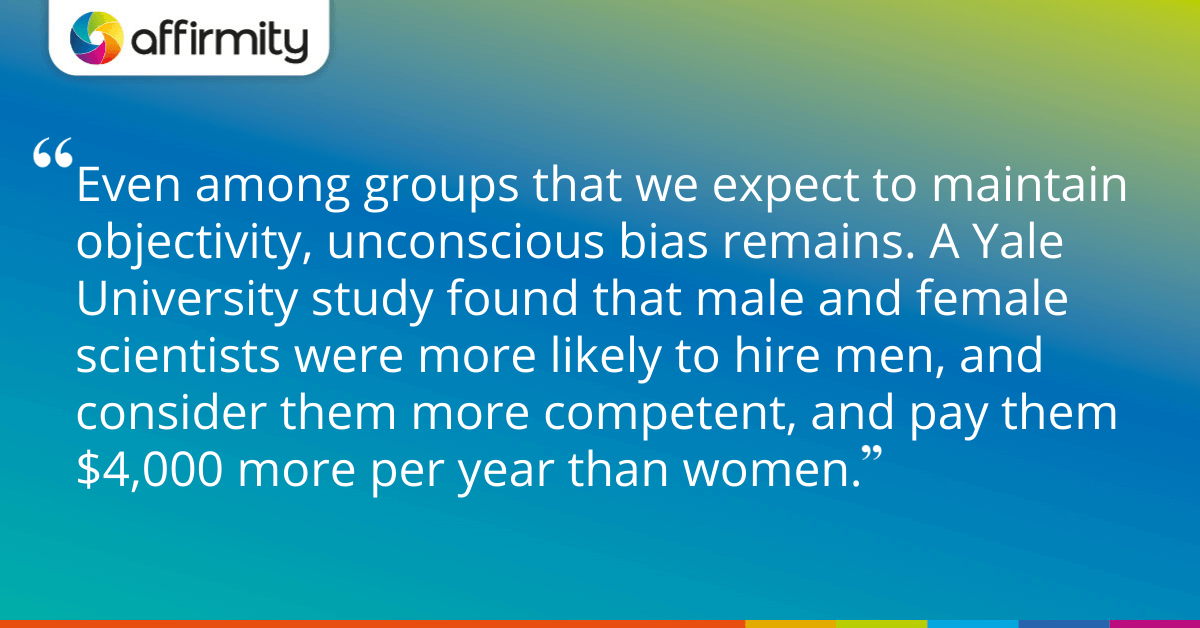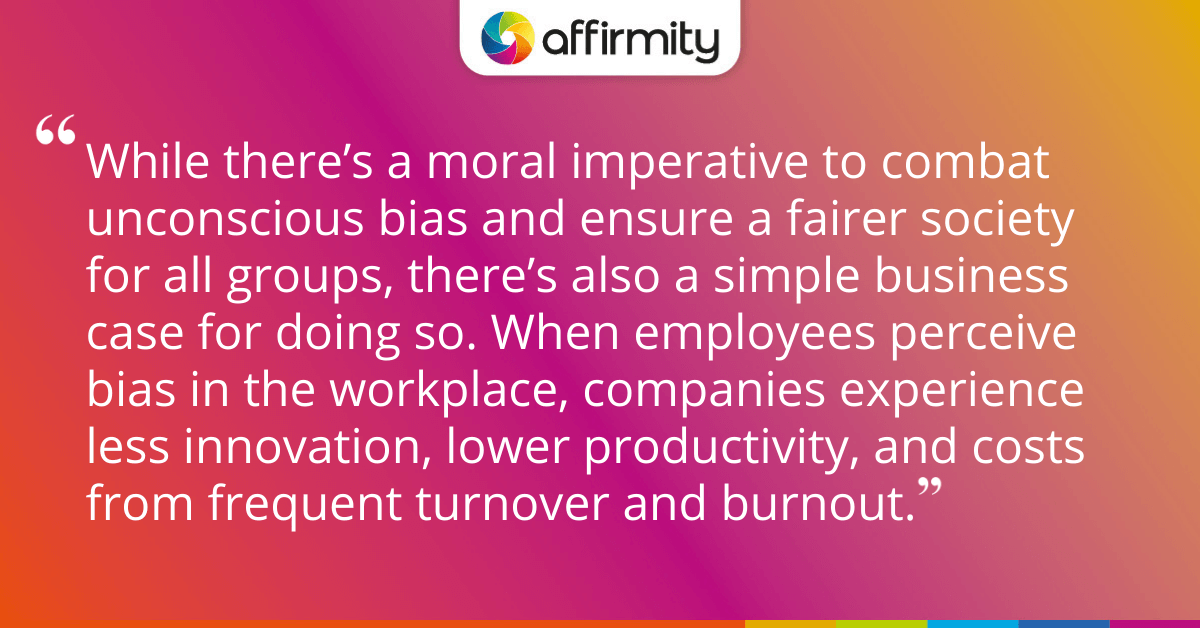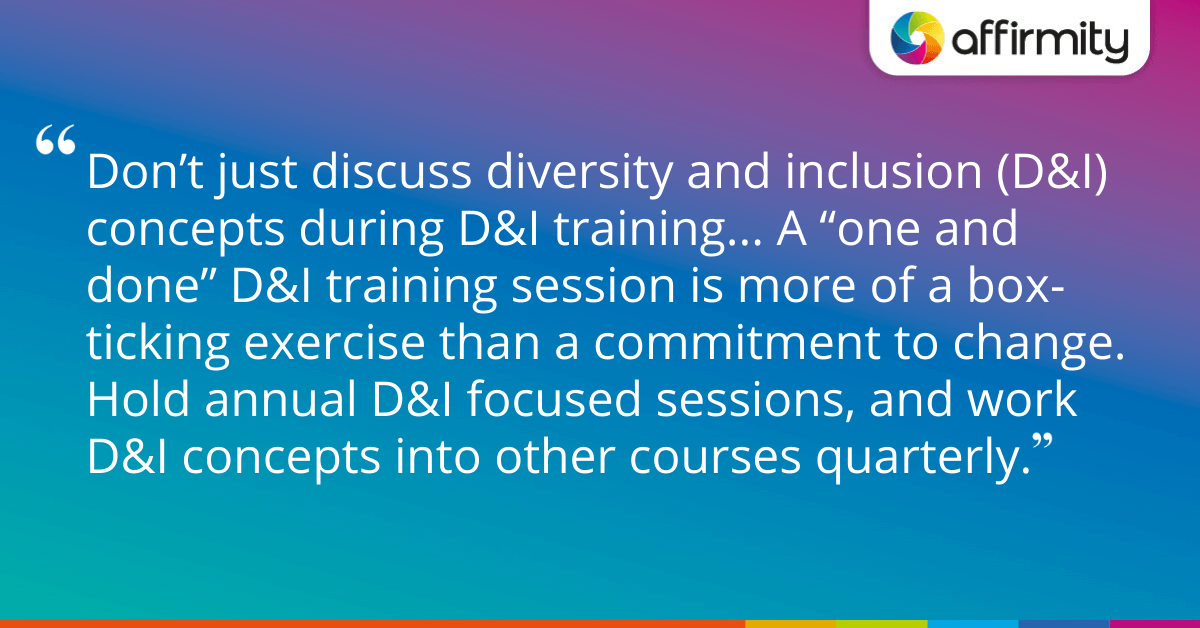Organizations and individuals actively avoid perpetuating damaging conscious biases. However, the reality is that regardless of our backgrounds, we’re all prone to unconscious bias—ones that potentially have destructive effects. In this article, we look at six facts, models, and solutions for tackling unconscious bias.
In our recent webinar ‘Shine a Light on Hidden Biases’, Affirmity experts Patrick McNiel, PhD, and Pamela Pujo discussed the origins and impact of unconscious bias. We’ve assembled a list of their best insights and tips below.
1) Unconscious Biases Are Partly a Product of Efficient Brains

The human brain is hardwired for prejudice. In our distant past, being able to quickly judge who was inside and outside of our immediate group was doubtlessly a valuable asset for survival. Though instincts serve us well in certain areas to this day, our in-group/out-group biases built in a hunter-gatherer society translate poorly to a modern-day working environment.
Even among groups that we expect to maintain objectivity, unconscious bias remains. A Yale University study found that male and female scientists were more likely to hire men, and consider them more competent, and pay them $4,000 more per year than women.
2) Unconscious Biases Aren’t a Product Of Any One Factor
While our tendency towards unconscious biases is innate, the development of biases is a multifaceted and ongoing process. The following can be significant contributors:
- Background and cultural: Bias is influenced by how we were raised, where we went to school, what places of worship we attended, the views of our parents and grandparents, and others we came into contact with.
- Social experience: Norms, customs, values, traditions, social roles, and languages provide individuals with the skills and habits necessary for participating within their own societies. Our social experiences shape our beliefs and, in turn, how we interact with people who are different from us.
- Biased media representations: Racial and ethnic stereotypes permeate television, movies, news, and social media. We may see a particular group more frequently displayed in a negative light in any of these mediums and become prone to viewing that group in a negative manner.
Also on the blog: ‘4 Great Ways to Help Embed Diversity & Inclusion as a Priority in Your Organization’
3) Unconscious Bias Has a Tangible Negative Effect

While there’s a moral imperative to combat unconscious bias and ensure a fairer society for all groups, there’s also a simple business case for doing so. A study from the Center for Talent Innovation looked at the costs of bias. When employees perceive bias in the workplace, companies experience less innovation, lower productivity, and higher costs associated with frequent turnover and burnout.
Of employees who experience bias:
- 34% reported withholding ideas for solutions in the last six months
- 48% said they had looked for a new job while at their current job in the last six months
- 75% said they aren’t proud to work for their companies
- 33% feel regularly alienated at work
4) We Can Make Simple Changes to Behavior to Get Ahead of Our Biases
What can individuals do to combat their own unconscious biases? The following actions can reduce the chances of biased behaviors:
- Ask questions rather than making assumptions:
- Ask people for feedback.
- Ask people how you can work together more effectively.
- Ask people when you aren’t sure what their thoughts, feelings, or motivations are.
- Ask yourself what assumptions you have made, and examine whether they are valid.
- Address misunderstandings and resolve disagreements:
- Don’t let an unpleasant interaction, misunderstanding, or disagreement fester and turn into an enduring spot of conflict on your team.
- If you have a simple misunderstanding, clear it up right away so everyone can be more productive.
- If you have a more substantial disagreement, use it as an opportunity to explore a meaningful difference of perspectives.
- Whenever you have a strong reaction to someone (positive or negative), ask yourself why.
ERGs present another organizational solution to unconscious bias. Find out more in this article: ‘Maximizing the Value of ERGs: Expert Answers to 7 Burning Questions’
5) Climate Surveys Help You Take Action
You can use climate surveys focused on diversity and inclusion to understand whether bias is an issue at your organization.
Diversity Climate Focus Areas
Representation: Do people see diversity in the organization across jobs and levels? Do people think of the company as a diverse place to work at?
Support and intentionality: Do people have the understanding that key figures in the organization want diversity, and are supportive of, and pushing for diversity?
Programming and implementation: Do people have an understanding that the company’s policies, processes, and procedures work to promote and support diversity?
Group dynamics: Do people treat others who may be different with respect, consideration, and fairness. Do they value diversity and see it as an asset?
Inclusion Climate Focus Areas
Belonging: Do people have a sense of warmth when they go to work? Do people like each other, and make each other feel like they belong? Does the company attempt to create that feeling?
Authenticity: Are people allowed to be themselves or do they need to put on a false front at work?
For an in-depth treatment of climate surveys, read our blog post, ‘How to Use a Climate Survey to Understand and Nurture Diversity and Inclusion’
6) How to Make Unconscious Bias Training a Success

Once you’ve analyzed your organization’s areas of bias and drawn up an action plan, you can implement an unconscious bias training program. This program should be measured, properly communicated, and effectively layered through the rest of your learning activity.
Measure Results
Ask behaviorally focused questions 90 days after completing unconscious bias training in order to understand whether or not transference of learning from the “classroom” to the job has occurred. Next steps include:
- Measure what participants have learned via pre- and post-assessments.
- Measure how your inclusion culture might have improved (or gotten worse).
- Participants should be made aware of what behaviors are expected of them in order to work on accomplishing those goals.
Communicate Frequently
Communicate how the training is anchored to a specific focus for the company, such as unbiased performance ratings or unbiased recruiting practices. Additionally, consider:
- How are you communicating upcoming sessions?
- Are you receiving support for the training from high levels within the organization?
- Will the training be mandatory or voluntary?
- What message are you communicating prior to the training regarding the reason for training?
Develop a Multi-Layered Curriculum
Don’t just discuss diversity and inclusion (D&I) concepts during DE&I training. Try the following:
- Use D&I concepts and skills in other courses such as customer service, sales, and patient safety.
- A “one and done” D&I training session is more of a box-ticking exercise than a commitment to change. Hold an annual D&I focused session, and work D&I concepts into other courses on a quarterly basis.
- Other types of training that can enhance valuable inclusion skills include conflict management, effective communications across cultures, intercultural awareness, and sessions dedicated to helping employees understand other divisions and job roles in the organization.
